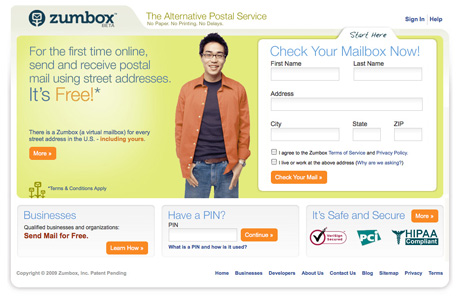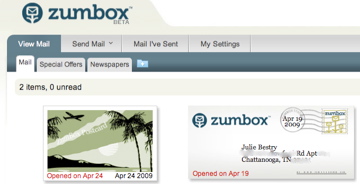Zooming With Zumbox
You can peg the children of Sesame Street and The Electric Company by their responses when you say something like “phenomena” (MahnahMahna…do doot de doo doo) or “You got soup?” (That’s Rita Moreno and Morgan Freeman’s Menu Song!) Similarly, people of a certain age, like Paper Doll, get a particular thought when they hear the Z and M sound, such as when the wide-eyed, vaguely European boy in the Mazda commercials intones “Zoom Zoom”. In fact, we get an uncontrollable urge to shout “Boston, Mass oh-two-one-three-four. Send it to Zoom!”
There’s some new zzmm buzz on the web these days, with a green twist that should appeal. Have you heard about Zumbox?

Right now, the site only serves the U.S., but has an intriguing business model to save the trees and eliminate the piles of bills, letters, investment prospectuses and junk mail letters that show up in our home or office mailboxes.
It’s not that you’ll get less mail, per se, but if the idea catches on, you’ll get less paper mail, and you’ll be able to control who can send you mail (Yes! to the shy but environmentally-conscious new neighbor who doesn’t know your email address; No! to the marketers trying to scam you about foreclosure protection).
Your street address is a matter of public record; even if you’ve opted out of receiving catalogs and other mail, paper mail keeps coming your way. But if green is your favorite color, here’s an option to limit the paper you do receive from people who have your physical address, without having to share your email address with anyone who don’t already trust to not send you the latest hoax or chain letter.
Zumbox posits itself as an alternative postal system, and they’ve created a virtual mailbox platform to match up with (they claim) every mailing address in the United States…including mine, yours and, one assumes, George Clooney’s. The point is that any business or person can send an electronic message to any who has a physical address, and the person who resides or works at that address can receive the message without a single tree cut down or paper cut received. You need not give out your email address, but you can still access the message electronically instead of having a mailbox full of paper.
The idea is that businesses, the folks that send the bulk (no pun intended) of the paper mail, will eventually need to switch over to a digital platform, but given that most internal records and mail systems are based on geography, it makes sense to have a digital platform that depends on getting mail to someone at a geographically-specific address.
It took Paper Doll some time to get a handle on exactly what Zumbox could realistically offer, so I walked myself through the steps on your behalf:
1) Go to Zumbox.com and register.
2) Provide your name and mailing address.
3) Agree to the boilerplate terms of service and privacy policy.
4) Confirm that it’s really your address.
It takes about 10 seconds unless you’re a really slow typist. You’ll immediately see one new Zumbox welcome “mail” in your account (similar to a web mail account).
You’ll also be notified that you’ll be getting an actual U.S. letter within a matter of days, at your home/office address, with your PIN number. This is the only time they’ll send paper mail, and one assumes it’s to make certain you haven’t pretended to be your neighbor to purloin an account. I registered on a Sunday, the envelope was postmarked Monday and I received it (three time zones away) on Thursday.
5) Return to Zumbox to type in your PIN (this one time only) and complete your account registration (with just a few additional pieces of info and a repeat confirmation that the address in question really is yours). From then on, you’ll log in with your selected username and password.
From there, you have multiple options:
- View mail you’ve received–It’s a nifty visual wherein you see what appears to be the “outside” of an envelope or the “front” of a post card. It seems it’s been designed to have the feel that you’ve just come from your mailbox and have spread the mail out on the counter to see what’s worth opening first. One imagines that as time goes on, there will be an option for a more typical, less graphical, inbox setup.

(Note: My attempt to quickly learn iPhoto to blur my address is imperfect…It’ll actually be crystal clear when you’re looking at your own account online.) Click to view and any envelope/card icon “opens”, letting you view what the actual mailing would look like if you’d received it on paper.
- View and read national, regional or local newspapers to which you’ve subscribed. (Of course, this is dependent upon publications making their materials available digitally, but that’s already happening more and more often.)
- View mail you’ve sent–In this section, mail is organized exactly as it would be in a typical webmail inbox, indicating various elements like date, mail type (postcard, letter, other), number of views, etc. No cutesie graphics here.
- Send postcards to any street address for a Zumbox user (or someone you, and Zumbox, expect to become a user). I sent one to myself as a test, and my inbox shows a cute picture postcard, the message for which I can see with one click.
- Send a letter to any street address for an actual or potential Zumbox user.
- Send invitations, birth announcements, church bulletins or anything else you might send in an envelope or on a postcard. Zumbox provides a mail wizard to send marketing campaigns for your business on a geographically-targeted basis. This means sending to any one of 150+ million U.S. street addresses you might have in your own address book or database. If you’re running a business or non-profit, you can select a specific geographic region–pick a city, state, county, zip code, street, specific building or even a mileage radius from a specific address.
Multiple formats are supported…you can send a Microsoft Word document or a PDF, raw data from a customer relationship management system like ACT, accounting software output, graphics, video, audio, HTML and oodles of formats, discussion of which is more suited for a technical blog than one on paper-decluttering. There’s generally no need for scanning, because most of what is sent in the mail starts out in digital form. If you like the marketing/business applications, you can check out the tech-y page here, or better yet, contact Zumbox directly. (Paper Doll found out about them on Twitter.)
Other options including maintaining an address book and/or blocking senders from getting their messages to you, and you can set a daily alert to remind you to check your Zumbox account. But the greenest aspect of Zumbox is that you can set your options to stop receiving paper mail altogether from any given sender.
I like the accountability. With email, spammers can fake an email address and take a stab at guessing your email address to send you email at no cost to them. (Grrrrrr.) With this system, marketers can’t be anonymous (because they have to use their REAL addresses from which to send Zumbox mail), plus you can stop unwanted mail from any sender.
Basically, Zumbox acts as your email address so that any/all the people and companies who send you mail at your physical address (and who don’t have–or whom you don’t want to provide–your email address) can get a message to you…without you having to divulge your email address or further harm coming to the environment.
Receiving mail via Zumbox is free for everyone. Sending mail may be free if you qualify for Zumbox’s free postage system for individuals and some non-profits, government agencies and businesses, but involves a nominal charge (five cents per mailing address) for others, such as greedy, evil, corporate types (kidding!). But even if your small company or organization doesn’t qualify for free sending, with the U.S. Postal Service raising rates yet again on May 11th, these charges are distinctly less than the cost of postage.
Of course, the efficacy of Zumbox depends on two huge “ifs”. First, will senders learn about Zumbox, trust it and will decide to use the service? The pizza parlor around the corner might eagerly do so if they find they’ll get a better response to their marketing efforts if they don’t ask customers for email addresses.
Aside from companies whose central non-revenue tenet is already environmental concern, will banks, utility companies and marketers play ball? Yes, this format is cheaper for junk-mailers to send that stuff you don’t want in the first place, but it’s also easier (and better for the planet) for you to dispose of the message without ever clicking, let alone shredding and carrying it to the recycling…and the senders will never get access to your actual email box.
But will companies buy into the idea? It seems Canada Post is already on the same wavelength with ePost, currently just for electronic delivery of bills, wherein companies send electronic messages to your ePost account, rather than to your email address. For those who change email addresses often and don’t always remember to notify corporate correspondents, this might work. Or not.
Second, will recipients set up accounts to receive digital versions of their mail at Zumbox? Certainly, if/when tha occurs, paper mail can be canceled and environmental joy shall abound! But none of this, if it happens at all, is going to happen overnight. Zumbox will have to communicate with potential users to make sure they understand that this isn’t a twist on something like Earth Class Mail, a company that charges receive your mail, open it, scan it and email it to you.
Paper Doll is no corporate trend prognosticator. I didn’t think people would create queues of DVDs they might want to watch, someday, and agree to pay a monthly fee for the privilege, because I considered movie viewing as a spontaneous, instant-gratification, pick-up/put-down/pick-up/carry-around experience. But that business model, technological advances, and Netflix killed the radio star (oops, I mean video store).
As I get on the road to the National Association of Professional Organizers annual conference to see what’s new and great in other organizing-related products and services, I turn to you to talk amongst yourselves about Zumbox. Great idea? Overly ambitious business model? What do you think?




Follow Me